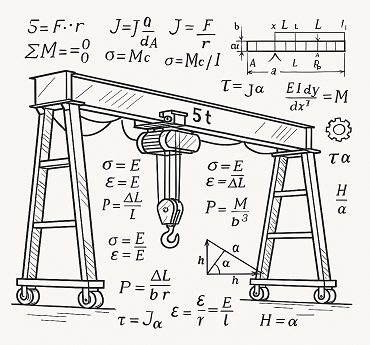Mechanical Design and Calculations in Overhead Cranes
Overhead cranes are among the most essential elements in industrial areas for load lifting and transport. For these cranes to operate safely and efficiently, a robust mechanical design and accurate calculations are required. Mechanical design ensures the structural integrity of the cranes, enabling high load capacities and durability. It also enhances mobility and operational efficiency.


Importance of Mechanical Design:
The mechanical design of overhead cranes requires careful planning and engineering calculations at every stage. The design is based on a variety of factors including loads, operating conditions, usage time, and environmental factors. Accurate calculations directly affect the functionality and durability of the cranes.
Main elements of mechanical design include:
Steel Structures:
The main load-bearing structures of cranes are made from high-strength steel materials. Material selection is based on calculated load capacities.
Hoisting Mechanisms:
Components such as hoist arms, ropes, and pulleys are designed to optimize lifting capacity and mobility.
Movement System:
Rail systems and wheels are designed to ensure smooth and uninterrupted crane travel.
Mechanical Calculations and Analyses:
The safety and performance of overhead cranes are based on accurate engineering calculations performed at every design stage and validated through various analyses. Key mechanical calculations include:
Load Capacity Calculations:
Determining the loads to be carried is the foundation of the design process. Each component is calculated based on its load-bearing capacity.
Static and Dynamic Load Analyses:
Static and dynamic loads encountered during crane operation determine safe working limits. These analyses ensure durability and safety.
Stress and Deformation Analyses:
Stress, deformation, and allowable deformation values in crane load-bearing sections are calculated to ensure structural safety.
Innovative Approaches in Design
The use of innovative technologies in the design process is of great importance. Design software and simulation tools help engineers perform faster and more accurate calculations. These tools allow for early detection and correction of design flaws.
Additionally, energy efficiency and environmental impact are also considered. Mechanisms that consume less energy are developed with sustainability in mind.
Conclusion
Mechanical design and calculations in overhead cranes are crucial for ensuring safety, efficiency, and long service life. Every detail is carefully calculated to achieve high-quality, reliable cranes. Investing in mechanical design significantly enhances safety and efficiency in industrial operations.
Contact Us
